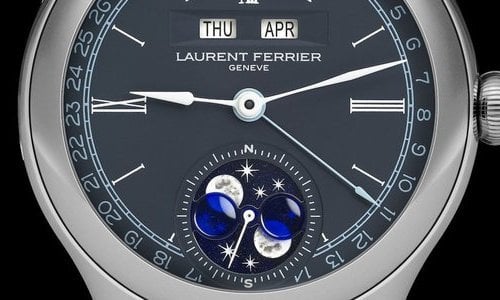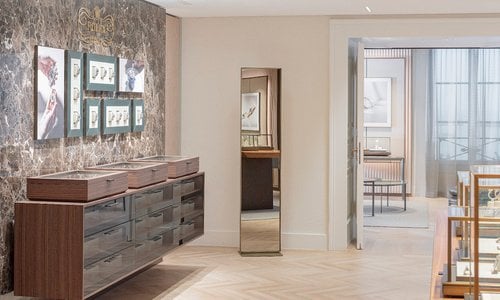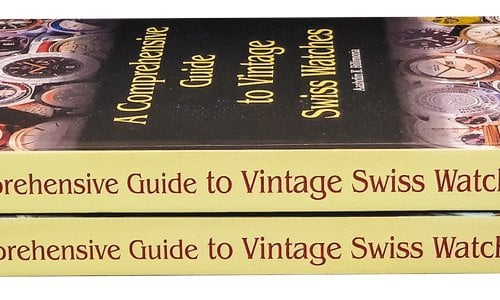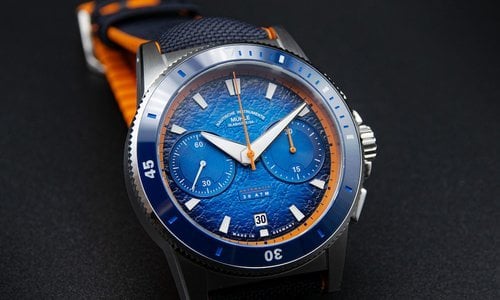How important are new developments in movements?
Felix Baumgartner, Urwerk: It's very important to develop new movements, new designs and new materials. We have to make these new ideas work, figure out how to make it technically possible. We have to then find the way to solve the problems, like the telescoping hands, which never existed before. For me, it's the passion of doing something new and different, to add something different to watchmaking. Our market is very specific and people who understand watches can appreciate what we are doing.
Denis Boulle, de Boulle Fine Jewelry: Critical. Without new designs and functions the 'gotta have' factor evaporates. For high-end consumers, however, the interest is in rarity and collectability rather than technological break-throughs.
Jasmina Steele, Patek Philippe: The most important thing in any new material or new technology development for Patek Philippe is that it brings an added benefit in terms of quality, long term reliability or timekeeping precision. We will not develop new technologies for marketing purposes only or replace traditional technology just for the sake of introducing something new without any important measured technical quality benefits.
Juan-Carlos Torres Vacheron Constantin: New developments are fundamental to support the brand's development and showcase/express our craftsmanship and mastery of technique. Developments must be kept under control so they do not enlarge the product offer. Our products have to remain rare and precious.
Stefano Macaluso, Girard Perregaux: At Girard-Perregaux, new developments are really at the centre of our strategy. As the company is a real integrated manufacture everything revolves around our movements: a new automatic base movement designed and developed by our internal R&D department needs several years of work and investment from the first brief to the launch.
Jorg Hysek, HD3: Today, these developments are more important than ever, because this development is totally bound to the aesthetical research for the case. The concept of designing a watch today is different from yesterday: both the case and the movement are developed together.
Jean Marc Jacot, Sandoz Family watch holding delegate: The most important thing for a manufacture is to have a collection of movements, going from a simple automatic movement through to the perpetual calendar, the minute repeater, chronograph, tourbillon, extra-flat, etc. - and not just one or two movements. Besides these ‘standard’ movements, it is also important to develop exceptional movements such as the Bugatti in the case of Parmigiani. The aim of Parmigiani is to have all these movements within three years.
Pierre-Michel Golay, Franck Muller Group: Developments in new movements are very important to the Franck Muller brands. We are working on creating several new different movements in order to apply our new concepts, new functions or new aesthetics.
Emmanuel Vuille, Vaucher Manufacture: In our opinion, a new development must, first of all, be useful. It must bring advantages in terms of reliability and/or precision. It is also important that this new development bring an all-round added value to the watch, either in terms of the ease of production or in terms of a useful and intelligent complication.
Anthony de Haas, Lange Uhren GmbH: It has always been Lange’s goal to find new solutions that underline the brands innovative skills and horological competence. We will continue to do all we can to surprise our customers with interesting and creative developments that live up to the brand’s claim 'state-of-the-art tradition'.
Is it important to find new materials, new architecture for watch movements?
Juan-Carlos Torres: For some very contemporary brands, new materials and architecture are essential to make them recognizable or to underline a permanent state of research and creativity. We prefer to consider the whole timepiece, including the movement, when speaking about new materials and new architecture. It is of prime importance to Vacheron Constantin not to forget about our positioning as an emblematic Maison of classical Haute Horlogerie. For this reason, we focus on creative and innovative concepts that include new techniques and new materials, but clearly inside our culture and our tradition. A very good example of this would be the Métiers d'Art ‘Les Masques’ collection launched this year.
Anthony de Haas: In principle I would say yes, we should extend our pursuit of new solutions to materials and architecture as well, but not as an end in itself. For us it is important that a new material or movement architecture serves a useful horological purpose and does not conflict with our self-imposed rules of traditional fine watchmaking.
Emmanuel Vuille: If the material or the new architecture doesn’t bring anything new and only possesses a marketing dimension, it should be considered as such. That doesn’t mean to say that it isn’t interesting, only that the development is not completely achieved. The use of new materials is interesting, but it must also bring something more, for example, in terms of lubrication or non-lubrication, or in terms of shock resistance.
Denis Boulle: It is important if it improves the watch and is a long-term improvement that will last the test of time, yes - making changes to just make something different, no. In 2005 Patek introduced, as an example, a silicon escapement that is the first of many developments using this material. Also in 2005 several companies made watches with two, three and even four tourbillons which did nothing but embarrass themselves.
Stephano Macaluso: R&D never stops: first of all we have to respect the tradition of watchmaking in terms of finishing and manufacturing, then we need to keep on innovating in terms of performance and reliability. New materials and innovative designs play an important role in this sense.
Jean Marc Jacot: New materials and new movement constructions are important if they improve the quality and functioning of the watch (precision/reliability).
What is the ultimate goal when developing new movements?
Juan-Carlos Torres: We have to ensure that the technique serves the aesthetic with an accuracy and a durability in respect of the Geneva Hallmark.
Stephano Macaluso: The ultimate goal consists of offering our customer a quality which will maintain a reliable performance for many years.
Jasmina Steele: For Patek Philippe the traditional rule of movement development remains, namely to develop the most complex features in the smallest volume possible (diameter and thickness) which is the most demanding challenge in terms of movement development and is the condition to keep the timeless elegance of our timepieces.
Emmanuel Vuille: Certain new movements are quite simply there to replace others that are not available, too expensive, or for other reasons. The development of a new movement can also become necessary in respect of its size, its obstacles or in respect of a function or a complication unique to this movement. For some brands, it can be important, even vital, to have their own movement inside their watch.
Jorg Hysek: Of course, our goal is to attract the client. We want to create something new but we want this something to be appreciated as well. The first motivation of a designer is always to create something new, something unique, and of course the movement can be part of this something new.
Where are mechanical movements going?
Anthony de Haas: The current development is marked by diversity. One direction leads towards modular designed complications. Others experiment with new materials and movement designs to create a futuristic impression. And there are, of course, the manufactures that follow the road of traditional mechanical watchmaking. Lange combines the latter with inventive competence because we are convinced that there are still many possibilities to invent exciting and useful new functions in watch movements.
Denis Boulle: More and more complications, some of which are frivolous, get sorted out by the market. Also, stronger, lighter and more wear resistant materials for key parts.
Juan-Carlos Torres: There are still a lot of creative aspects to develop within the traditional movements decoration – like the new Côtes de Genève patterns and contemporary skeletonization - still with the highest level of accuracy and durability in respect of the Geneva Hallmark.
Jorg Hysek: We are looking for new ways of telling time, and we have to find new mechanical ways, new interesting motors. Precision in timekeeping is not so important anymore, the most important and the most difficult is to be able to read time, in a new and aesthetical way.
Stefano Macaluso: Many brands are developing new movements and complications and some of them are very interesting. It’s hard to tell how many within these concepts will really change the watchmaking field, but I’m sure that a selection of these improvements will bring into the market better products for our customers.
Is combining mechanical and quartz movements a direction of interest?
Emmanuel Vuille: Personally, I believe that mechanical watches have a bright future in front of them. However, we can’t rule out that during the next few years, we will see the appearance of hybrid watches, with a mix between mechanical and electronic parts, or other combinations. Personally, I think that one day our children will be interested by hybrid watches, in particular, with certain complications or certain functions that we could integrate into a mechanical watch.
Stefano Macaluso: I think both mechanical and quartz movements have strong legacies. Today our brand is mostly focused on and demanded for mechanical watches, but we never rule out the possibility of coming back with sophisticated and prestigious quartz models in the future.
Pierre-Michel Golay: Certainly it could be a direction of interest. A beautiful mechanical movement could be combined with a quartz movement, but we don’t have any projects within Franck Muller today.
Jean Marc Jacot: Regarding Parmigiani, the combination of quartz and mechanical is not at the centre of our research at the moment. For some time, other brands have been working and launching such movements, but in terms of haute horlogerie, it is not the same philosophy.
Jorg Hysek: This is interesting, but I don’t think it is the most important direction. However, we are using more and more electronic devices in order to supervise some mechanical parts, for example the automatic time setting of a second time zone. The information is electronic but done mechanically.
Anthony de Haas: This is unimaginable for a brand like A. Lange & Söhne.
Juan-Carlos Torres: This is definitely not a direction for us as we foster a tradition of mechanical watchmaking within the highest standards of the Geneva Seal.
The mechanical watch is here to stay, but in what variations remain to be seen.
Source: Europa Star August-September 2007 Magazine Issue




